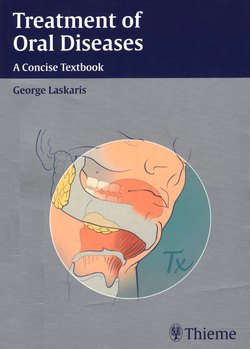Читать книгу Treatment of Oral Diseases - George Laskaris - Страница 24
ОглавлениеBehçet Disease
Definition
Behçet disease is a chronic multisystemic relapsing inflammatory disorder of uncertain cause and prognosis. It is classified among the systemic vasculitides.
Etiology
The etiology of Behçet disease remains unknown, however, there is ample evidence favoring multifactorial pathogenesis. Autoimmunity may be one of the factors. Recently it has been proposed that the tumor necrosis factor (TNF) may play a central role in the pathogenesis of this inflammatory process.
Main Clinical Features
The disease usually begins during the third decade of life and there are periods of remission and exacerbation. The main clinical features include oral lesions, genital ulcerations, skin and ocular lesions, and arthropathy. The pathergy test is positive in approximately 50-60% of the cases.
Oral Lesions
Aphthous ulcers (minor, major, herpetiform or atypical ulcers) are the most common and occur early in the course of the disease
Genital Lesions
Genital ulcers, similar to aphthous ulcers, in the scrotum, penis, and vulva are common
Skin Lesions
Papules, pustules, nodules, erythema nodosum, folliculitis, necrotic angiitis, and ulcers are the most common skin lesions
Ocular Lesions
Conjunctivitis, iritis with hypopyon, uveitis, and retinal vasculitis (which may occasionally lead to blindness)
Other Features
Seronegative mono-polyarthritis, epididymitis, venous thrombosis, arterial aneurysms, glomerulonephritis, pulmonary vasculitis, pericarditis, endocarditis, neurological disorders, and others
Diagnosis
The diagnosis of Behçet disease is based almost exclusively on the history and the clinical features, since there are no pathognomonic laboratory tests.
Differential Diagnosis
•Aphthous ulcers
•FAPA syndrome
•Herpes simplex infection
•Erythema multiforme
•Stevens-Johnson syndrome
•Reiter syndrome
•Pyostomatitis vegetans
•Pemphigus
•Cicatricial pemphigoid
•Systemic lupus erythematosus
•Ulcerative colitis
•Crohn disease
•Rheumatoid diseases
•Lung sarcoidosis
Treatment
Basic Guidelines
•Accurate diagnosis is the most important step for successful therapy.
•A team of specialists should be involved in the treatment of Behçet disease, including a stomatologist, an ophthalmologist, a dermatologist, a rheumatologist, a gastroenterologist, and others. The treatment is adapted to the individual patient based on their clinical signs and symptoms.
•Both topical and systemic treatments are used. Mild forms of the disease respond well to topical treatment, while in severe and multisystemic forms systemic treatment is required.
•The treatment of severe forms must be undertaken by the specialists.
Suggested Therapies
Systemic Treatment
Corticosteroids
Systemic oral corticosteroids, usually prednisone, are the drugs of choice for the treatment of Behçet disease. The initial dose varies from 30 mg/day to 80 mg/day or more depending on the severity of the disease and organ involved. After the disease has been controlled the dose is tapered gradually to 5-10 mg/day for long periods of time. Corticosteroids may be used either alone or in combination with azathioprine or other immunosuppressives.
Immunosuppressive Drugs
Azathioprine 50-100 mg/day appears to be effective, particularly for ocular and oral lesions. Cyclosporine 2-3 mg/kg day, cyclophosphamide 1-2 mg/kg day, chlorambucil 0.1 mg/kg day have also been used, in particular, for the treatment of ocular lesions. These drugs are used with or without corticosteroids.
Other Drugs
Colchicine 0.5-2 mg/day, and dapsone 100 mg/day can be used to treat particular oral and cutaneous lesions. Thalidomide 50-200 mg/day seems to be effective for oral lesions. Colchicine and thalidomide are absolutely contraindicated during pregnancy. Pentoxifylline 800 mg/day has recently been used, particularly for the treatment of oral, cutaneous, and ocular lesions. Nonsteroidal anti-inflammatory drugs are helpful in cases where there is joint involvement.
Topical Treatment
Painful oral aphthous ulcers require topical treatment alone or usually in association with systemic treatment.
Topical treatment is aimed at a) elimination of pain and discomfort, b) shortening of the duration of lesions, and c) avoidance of recurrence. Topical corticosteroids in the form of 0.1% triamcinolone acetonide, or 0.05% clobetasol in an oral adhesive base (Orabase), or fluocinonide gel applied to the ulcer three to six times a day, are the mainstay of topical therapy. Inhaled corticosteroids have also been used for ulcers in the soft palate and posterior vestibule.
Topical anesthetics such as 5% lidocaine (Xylocaine) ointment or viscous gel or diphenhydramine hydrochloride (Benadryl elixir) reduce the pain for a short time only. Recently, 5% amlexanox (Aphthasol) oral paste or 3% diclofenac in 2.5% hyaluronan has been shown to reduce the pain and shorten the duration of the ulcers. Topical tetracycline mouthwashes or application of tetracycline compresses have been used with partial success. Topical 5% 5-aminosalicylic acid or silver nitrate stick application may provide relief from pain and shorten the duration of the ulcers.
Genital ulcers and skin lesions can be treated topically with corticosteroids and antimicrobial ointments or creams. Local treatment of ocular lesions must be undertaken by an ophthalmologist.
Alternative Therapies
Interferon alpha, mycophenolate mofetil, tacrolimus, sulfasalazine, and anticoagulants have been suggested as alternative treatments in severe and resistant cases. Recently, rebamipide (a gastroprotective drug) has been recommended as a long-term adjunctive treatment for recurrent oral aphthous ulcers in patients with Behçet disease. Anti-TNF therapy has also been used with success.
References
Binnie WH, Curro FA, Khandwala A, Van Inwegan RG. Amlexanoral paste: a novel treatment that accelerates the healing of aphthous ulcers. Compend Contin Educ Dent 1997;118:1116-1118. 1120–1122.
Collier PM, Neill SM, Copeman PW. Topical 5-aminosalicylic acid: A treatment for aphthous ulcers. Br J Dermatol 1992;126:185–188.
De Tran QH, Guay E, Chattier S, Tousignant J. Tacrolimus in dermatology. J Cutan Med Surg 2001;5:329–335.
Goker B, Goker H. Current therapy for Behçet’s disease. Am J Ther 2002;9:465–470.
Matsuda T, Ohno S. Hirohata Y, et al. Efficacy of rebamipide as adjuncrive therapy in the treatment of recurrent oral aphthous ulcers in patients with Behçet’s disease: a randomized, double-blind, placebo-controlled study. Drugs R D 2003;4:19–28.
Sfikakis PP. Behçet’s disease: A new target for anti-tumour necrosis factor treatment. Ann Rheum Dis 2002;61 (sup-pl 2):51–53.
Sharquie KE, Najim RA, Abu-Raghif AR. Dapsone in Behçet’s disease: A double-blind, placebo-controlled, crossover study. J Dermatol 2002;29:267–279.
Shek LP, Lim DL. Thalidomide in Behçet’s disease. Biomed Pharmacother 2002;56:31–35.
Stratigos A, Laskaris G, Laskaris J. Behçet’s disease. Semin Neurol 1992;12:346–357.
